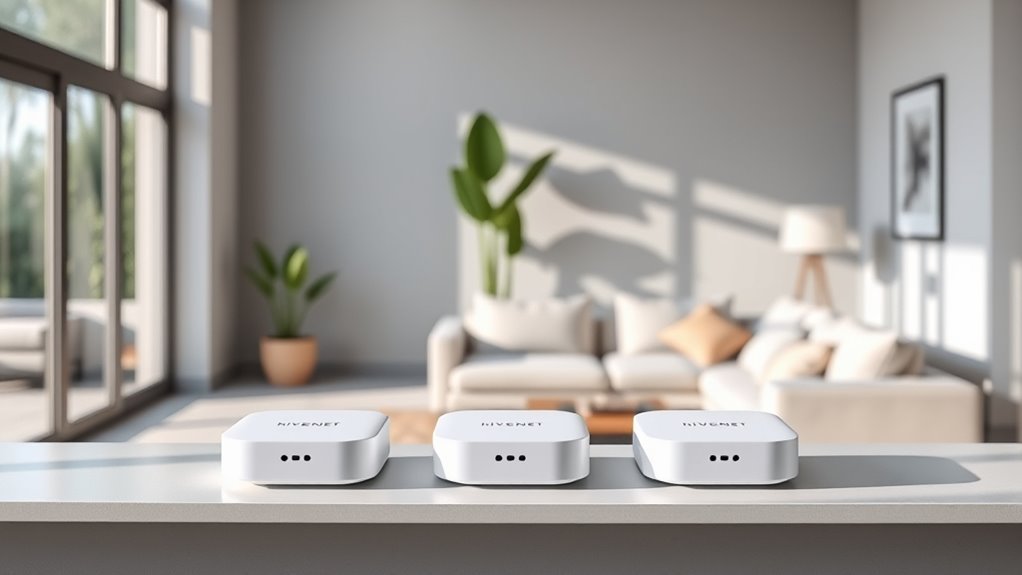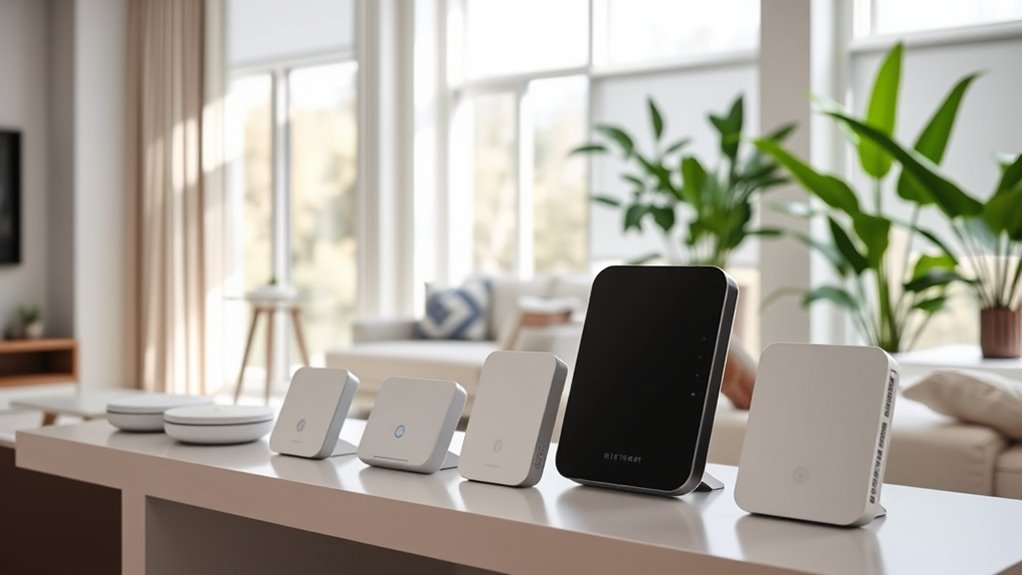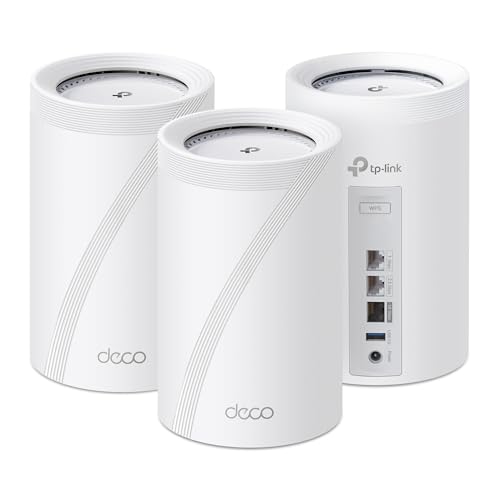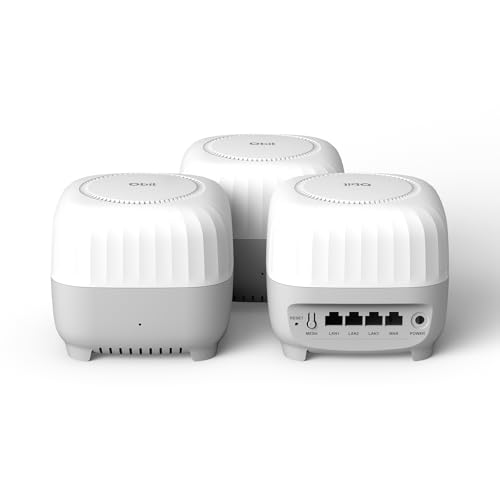I’ve explored some of the best multi-room Wi-Fi mesh systems that guarantee seamless connectivity throughout your home. The TP-Link Deco X20, Amazon eero 6, and NETGEAR Nighthawk MK73S stand out with impressive coverage and speed. If you need extensive area coverage, look into the TP-Link Deco BE67 or Google Nest WiFi Pro. They’ve got features to support all your devices. Keep going to discover more details about these top-performing systems that can transform your Wi-Fi experience!
Key Takeaways
- Look for mesh systems with extensive coverage, such as TP-Link Deco BE67, which supports up to 8,100 sq. ft. for large homes.
- Opt for devices supporting Wi-Fi 6 or Wi-Fi 7 for faster speeds and better device handling, like the TP-Link Deco BE63.
- Choose systems with easy setup and management through apps, such as Amazon eero 6, which integrates with Alexa for added convenience.
- Consider security features like parental controls and automatic updates, which are available in models like Deco X20 and NETGEAR Orbi.
- Evaluate your current and future connectivity needs to ensure the selected mesh system provides value, speed, and scalability as your device count grows.
TP-Link Deco WiFi 6 Mesh System (Deco X20) – 3-Pack
If you’re tired of dead zones and buffering in your home, the TP-Link Deco WiFi 6 Mesh System (Deco X20) – 3-Pack is just what you need. This system covers up to 5800 sq. ft. with seamless Wi-Fi 6, ensuring strong connectivity everywhere. I love how it supports up to 150 devices simultaneously, making it perfect for my smartphones and smart home gadgets. Plus, setup is a breeze with the Deco app, and I can even control settings with Alexa. With six Gigabit Ethernet ports, I enjoy flexible network configurations and improved speeds. It’s an essential upgrade for any home!
Best For: Large households or tech-savvy individuals who need reliable, high-speed internet coverage throughout their home.
Pros:
- Seamless coverage of up to 5800 sq. ft., eliminating dead zones and buffering.
- Supports up to 150 devices simultaneously, perfect for smart homes and multiple users.
- Easy setup and management via the Deco app, with compatibility for Alexa voice control.
Cons:
- Requires a modem for most internet service providers, which may add to setup complexity.
- Some users may find the initial cost higher than traditional routers or extenders.
- Performance may vary based on the layout of the home and the number of obstructions.
TP-Link Deco S4 Mesh WiFi System (3-Pack)
The TP-Link Deco S4 Mesh WiFi System (3-Pack) stands out as an ideal choice for anyone seeking reliable, expansive WiFi coverage in larger homes or multi-building setups. It covers up to 5,500 sq. ft., eliminating dead zones with its Deco Mesh technology. I love that it supports up to 100 devices, ensuring seamless connectivity. Setup is a breeze with the Deco app, which also lets me manage settings like guest WiFi and parental controls. Users consistently rave about its stability and performance, making it a solid investment for those needing robust internet across multiple floors or buildings.
Best For: Those seeking reliable and expansive WiFi coverage in larger homes or multi-building setups.
Pros:
- Easy setup and management through the Deco app, including features like guest WiFi and parental controls.
- Supports up to 100 devices, ensuring seamless connectivity across multiple floors or buildings.
- Effective coverage of up to 5,500 sq. ft., eliminating dead zones with Deco Mesh technology.
Cons:
- Firmware updates may require manual installation due to occasional issues with the update portal.
- Some users report the need for regular rebooting to maintain optimal performance.
- The app may have limitations that could affect advanced users seeking more customization options.
Amazon eero 6 Mesh WiFi System (3-Pack)
Looking for a Wi-Fi solution that covers large homes and supports multiple devices? The Amazon eero 6 Mesh WiFi System (3-Pack) might be just what you need. It effortlessly blankets up to 5,000 sq ft with speeds up to 500 Mbps. With Wi-Fi 6 technology, it handles over 75 devices, making it perfect for busy households. I love how easy the setup is through the eero app, and the system automatically updates for improved security. Although some may find the price a bit high, the reliable coverage and performance are well worth it. Plus, it’s easily expandable as your needs grow!
Best For: Busy households that require reliable Wi-Fi coverage for multiple devices across large spaces.
Pros:
- Easy setup and management through the user-friendly eero app.
- Supports over 75 connected devices with excellent coverage and speeds.
- Automatically updates for enhanced security and performance.
Cons:
- Some users report issues with ISP compatibility and DHCP configurations.
- Limited local management features due to reliance on cloud processing.
- Higher price point compared to traditional routers may deter some buyers.
Linksys Multi-gig Micro Mesh WiFi 6 System (2024 Release)
For households with heavy internet usage, the Linksys Multi-gig Micro Mesh WiFi 6 System (2024 Release) stands out as an ideal choice. It offers seamless coverage up to 5,000 sq ft, perfect for two-story homes and outdoor areas. With speeds reaching 3.0 Gbps and support for over 100 devices, it’s fantastic for streaming, gaming, and downloads. Setup is a breeze, and while the app has mixed reviews, it simplifies management. Though some users report minor issues with firmware and hardware, most appreciate the reliable performance and attractive design, making it a top contender for fast, consistent Wi-Fi throughout your home.
Best For: Households with heavy internet usage that require reliable, high-speed WiFi coverage across large areas.
Pros:
- Seamless coverage up to 5,000 sq ft, eliminating dead zones in larger homes and outdoor spaces.
- High speeds of up to 3.0 Gbps, supporting streaming, gaming, and downloads without buffering.
- Easy setup process and expandable design, allowing users to enhance coverage effortlessly.
Cons:
- Some users report firmware compatibility issues with older devices or previously manufactured units.
- The app has mixed reviews regarding usability and advanced management options.
- Occasional hardware overheating concerns and disconnections of satellite nodes have been noted.
TP-Link Deco BE23 Dual-Band WiFi 7 Mesh System (2-Pack)
With its support for Wi-Fi 7 technology and impressive coverage of up to 4,500 sq. ft., the TP-Link Deco BE23 Dual-Band WiFi 7 Mesh System (2-Pack) is an ideal choice for large households or anyone who relies heavily on multiple smart devices. I love that it supports up to 150 devices simultaneously without sacrificing performance. The setup is straightforward using the Deco app, and I appreciate the robust security features, including parental controls and DoS protection. With speeds reaching 3.6 Gbps, my streaming and gaming experiences are seamless. This system truly enhances my home’s connectivity, making it a worthwhile investment.
Best For: Large households or users with multiple smart devices seeking high-speed, reliable Wi-Fi coverage.
Pros:
- Supports up to 150 devices simultaneously without performance degradation.
- Offers robust security features, including parental controls and DoS protection.
- Easy setup through the Deco app with seamless mesh networking capabilities.
Cons:
- Initial device identification can be time-consuming due to non-descriptive labels.
- Some connectivity issues with the app may require device restarts to resolve.
- Limited Alexa control features for managing wired devices.
Amazon eero 6+ Mesh WiFi System (3-Pack)
The Amazon eero 6+ Mesh WiFi System (3-Pack) is an ideal choice for anyone needing robust internet coverage in larger homes. With speeds up to 1 Gbps, it efficiently supports over 75 devices, making it perfect for streaming, video calls, and remote work. I love how its TrueMesh technology eliminates dead spots, ensuring consistent connectivity throughout my space. Setup is a breeze with the eero app, which also allows for remote management. Plus, the built-in Zigbee hub simplifies smart home integration with Alexa. With excellent customer support and automatic updates, it’s a future-proof investment for any household.
Best For: Families or individuals in larger homes who require reliable, high-speed internet coverage for multiple devices and smart home integration.
Pros:
- High performance with speeds up to 1 Gbps, supporting over 75 devices simultaneously.
- TrueMesh technology minimizes dead spots and ensures stable connections throughout the home.
- Easy setup and management via the eero app, with automatic updates for enhanced security.
Cons:
- Subscription required for advanced security and management features.
- Initial cost of the 3-pack system may be higher than basic routers.
- Limited advanced customization options for tech-savvy users compared to more complex networking solutions.
TP-Link Deco BE63 Tri-Band WiFi 7 Whole Home Mesh System (3-Pack)
If you’re seeking a robust solution for a large smart home, the TP-Link Deco BE63 Tri-Band WiFi 7 Whole Home Mesh System (3-Pack) stands out with its impressive coverage of up to 7,600 sq.ft. This system delivers ultra-fast Wi-Fi 7 speeds, supporting over 200 devices simultaneously. With its easy setup via the Deco app, I found managing my network smooth and straightforward. The built-in HomeShield enhances security, while the option for multi-gig internet connectivity future-proofs my home network. Plus, the mesh technology ensures seamless streaming and gaming, making it a perfect choice for anyone needing reliable connectivity throughout their home.
Best For: Large smart homes requiring robust Wi-Fi coverage and support for multiple devices.
Pros:
- Ultra-fast Wi-Fi 7 speeds with coverage for up to 7,600 sq.ft.
- Supports over 200 devices simultaneously, ideal for extensive smart home setups.
- Easy management and setup via the TP-Link Deco app, enhanced security with HomeShield.
Cons:
- Initial cost may be higher compared to standard Wi-Fi 6 systems.
- Requires an understanding of network management for optimal configuration.
- May need additional nodes for very large or complex layouts beyond the 3-pack coverage.
TP-Link Deco XE75 Pro Tri-Band WiFi 6E Mesh System (2-Pack)
Looking for a robust Wi-Fi solution for a large home? The TP-Link Deco XE75 Pro Tri-Band WiFi 6E Mesh System (2-Pack) delivers exceptional coverage up to 5,500 sq.ft., ensuring seamless connectivity throughout your space. With speeds reaching 5,400 Mbps across its three bands, including a new 6 GHz band, you’ll experience minimal interference and stable connections. Setting it up is a breeze with the Deco app, guiding you through placement and optimization. Users rave about its impressive performance for 4K streaming and gaming, along with easy management features like device prioritization and guest WiFi controls. It’s a fantastic choice for demanding households!
Best For: Families and individuals seeking a high-speed, reliable Wi-Fi solution for large homes with multiple devices and demanding internet usage.
Pros:
- Exceptional Coverage: Provides WiFi coverage up to 5,500 sq.ft., ideal for large homes.
- High Speeds: Delivers up to 5,400 Mbps across three bands, ensuring smooth streaming and gaming experiences.
- User-Friendly Management: Easy setup and management through the Deco app, including features like device prioritization and guest WiFi controls.
Cons:
- Requires Modem: A separate modem is needed for most internet providers, which may be an additional cost.
- Initial Setup Location Dependent: Optimal performance may require careful placement of units, necessitating testing for best signal strength.
- Limited Advanced Configuration Options: Some advanced users may find the customization options insufficient compared to more professional-grade systems.
NETGEAR Orbi 370 Series Dual-Band WiFi 7 Mesh Network System (RBE374)
For anyone needing robust Wi-Fi coverage in a large home, the NETGEAR Orbi 370 Series Dual-Band WiFi 7 Mesh Network System (RBE374) stands out as an excellent choice. With speeds up to 5 Gbps, it easily supports 4K streaming, gaming, and video conferencing. The system covers up to 8,000 sq. ft. and connects up to 70 devices seamlessly. I love its elegant design and 360° coverage, which eliminates dead zones. Setup via the Orbi app is a breeze, and built-in security features keep my network safe. Overall, this mesh system enhances my connectivity experience, making it ideal for any smart home.
Best For: Those seeking high-speed, reliable Wi-Fi coverage in large or complex homes, ideal for 4K streaming, gaming, and smart home integration.
Pros:
- Supports speeds up to 5 Gbps, perfect for simultaneous streaming and gaming across multiple devices.
- Covers up to 8,000 sq. ft. with 360° Wi-Fi coverage, effectively eliminating dead zones.
- Easy setup and management through the Orbi app, along with robust security features.
Cons:
- Higher price point compared to traditional mesh systems.
- Occasional satellite disconnects reported by some users.
- Maximum performance often requires wired connections for satellites.
Amazon eero 7 Dual-Band Mesh Wi-Fi 7 Router (2-Pack)
The Amazon eero 7 Dual-Band Mesh Wi-Fi 7 Router (2-Pack) stands out as an ideal choice for anyone needing robust coverage in larger homes, thanks to its impressive reach of up to 4,000 sq. ft. With support for internet speeds up to 2.5 Gbps, it handles over 120 devices effortlessly. The setup is a breeze through the eero app, making management intuitive. I love its smart home integration with Alexa and Zigbee, allowing seamless automation. Although some users experienced occasional offline issues, the overall performance and aesthetic design make it a fantastic upgrade for reliable and fast Wi-Fi throughout my home.
Best For: Families or individuals in larger homes seeking reliable, high-speed internet coverage for multiple devices.
Pros:
- Easy setup and management through the user-friendly eero app.
- Impressive coverage up to 4,000 sq. ft., supporting over 120 devices seamlessly.
- Strong smart home integration with Alexa and Zigbee, enhancing automation capabilities.
Cons:
- Some users report occasional offline issues with the base unit.
- Signal strength may be limited in older brick or layered homes.
- Additional features like eero Plus require a separate subscription.
TP-Link Deco BE67 Tri-Band WiFi 7 Whole Home Mesh System (3-Pack)
If you’re seeking a robust solution for a large home filled with smart devices, the TP-Link Deco BE67 Tri-Band WiFi 7 Whole Home Mesh System is an excellent choice. With Wi-Fi 7 technology delivering up to 14 Gbps across 8 streams, this system supports high-speed activities like 4K streaming and gaming. It covers up to 8,100 sq. ft., ensuring no dead spots. The easy setup via the Deco App, along with strong security features, makes managing your network a breeze. Plus, it handles up to 200 devices simultaneously, keeping your family’s connectivity smooth and reliable.
Best For: Families with large homes and multiple smart devices seeking high-speed, reliable Wi-Fi coverage.
Pros:
- Supports Wi-Fi 7 technology with speeds up to 14 Gbps, ideal for 4K streaming and gaming.
- Covers up to 8,100 sq. ft., eliminating dead spots and maintaining strong signals in large areas.
- User-friendly setup via the Deco App and robust security features ensure easy management and protection of your network.
Cons:
- Limited advanced configuration options may not satisfy tech-savvy users looking for more control.
- Speed test discrepancies have been reported, leading to some confusion regarding actual performance.
- VLAN support issues in AP mode can be a drawback for users needing specific network configurations.
DBIT AC1200 Whole Home Mesh WiFi System (D-MAC3, 3-Pack)
Ideal for large homes or offices, the DBIT AC1200 Whole Home Mesh WiFi System (D-MAC3, 3-Pack) guarantees seamless connectivity across up to 6,000 square feet. I love how it replaces traditional routers and extenders, eliminating dead zones with its smart roaming technology. With speeds up to 1200Mbps, I can stream 4K content and game without lag. The system supports over 90 devices and includes four Gigabit Ethernet ports on each node for stable wired connections. Plus, its robust security features and parental controls give me peace of mind. Overall, it’s a solid choice for all-encompassing Wi-Fi coverage.
Best For: The DBIT AC1200 Whole Home Mesh WiFi System is best for large homes or offices that require extensive Wi-Fi coverage and seamless connectivity.
Pros:
- Eliminates dead zones with smart roaming technology, ensuring stable connections throughout up to 6,000 sq ft.
- Supports streaming and gaming with speeds up to 1200Mbps and accommodates over 90 simultaneous device connections.
- Offers robust security features, including WPA3 encryption and comprehensive parental controls for safe browsing.
Cons:
- Initial setup may be challenging for beginners, requiring multiple attempts for successful configuration.
- Some users report connectivity issues with the app, particularly during the initial setup process.
- Optimal performance may require Ethernet cables between nodes, which could add to setup complexity.
NETGEAR Nighthawk Tri-Band Whole Home Mesh WiFi 6 System (MK73S)
Looking for a robust solution to cover your entire home with seamless Wi-Fi? The NETGEAR Nighthawk Tri-Band Whole Home Mesh WiFi 6 System (MK73S) has you covered. With a range of up to 4,500 sq. ft., it easily supports over 25 devices at once. You’ll enjoy AX3000 Gigabit speeds for smooth streaming, gaming, and video calls. Plus, it includes three Ethernet ports for wired connections. Security is premier with NETGEAR Armor, providing real-time protection against threats. Setting it up is a breeze using the Nighthawk app, ensuring you stay connected effortlessly throughout your home.
Best For: Families or individuals looking for extensive Wi-Fi coverage and high-speed internet for multiple devices simultaneously.
Pros:
- AX3000 Gigabit speeds ensure smooth streaming, gaming, and video conferencing experiences.
- NETGEAR Armor provides robust security features with real-time protection against cyber threats.
- Easy setup and management through the Nighthawk app allows for seamless installation and control over Wi-Fi settings.
Cons:
- Designed for US use only, limiting availability for international users.
- Requires a subscription for extended use of NETGEAR Armor after the first year.
- Performance may vary depending on home layout and interference from other devices.
Google Nest WiFi Pro – 6E Mesh Router (3 Pack)
The Google Nest WiFi Pro – 6E Mesh Router (3 Pack) stands out for anyone seeking a robust solution for large homes, covering up to 6,600 square feet with fast, reliable Wi-Fi. With speeds up to twice as fast as Wi-Fi 6, it guarantees seamless connectivity across multiple devices. The three frequency bands—2.4 GHz, 5 GHz, and 6 GHz—optimize performance for everything from streaming to video calls. Plus, it automatically adjusts for activity and self-diagnoses issues, which keeps your network running smoothly. If you want a dependable mesh system that adapts to your home’s needs, the Nest WiFi Pro is a solid choice.
Best For: Those seeking a high-speed, reliable Wi-Fi solution for large homes with extensive coverage needs.
Pros:
- Fast Speeds: Delivers speeds up to 2x faster than Wi-Fi 6, ensuring seamless connectivity.
- Wide Coverage: Covers up to 6,600 square feet, making it ideal for larger homes.
- Smart Management: Automatically adjusts network performance and self-diagnoses issues to maintain optimal operation.
Cons:
- Incompatibility: Not compatible with previous Google Wifi or Nest Wifi generations.
- Price Point: Higher cost compared to traditional routers may not suit all budgets.
- Complex Setup: Setting up a mesh network can be more complex than a standard router.
Factors to Consider When Choosing Multi‑Room Wi‑Fi Mesh Systems

When choosing a multi-room Wi-Fi mesh system, I consider several key factors. Coverage area, device compatibility, speed, ease of setup, and security features all play vital roles in my decision. Let’s explore each of these aspects to help you make the best choice for your home.
Coverage Area Requirements
Accurately measuring your home’s square footage and layout is essential for selecting a multi-room Wi-Fi mesh system that meets your coverage needs. If you live in a larger home or a multi-story building, look for systems that cover over 5,000 sq ft with multiple nodes. I’ve noticed that open floor plans usually require fewer nodes, while homes with many walls or obstructions might need extra units. Don’t forget to take into account outdoor areas, garages, or basements when estimating coverage; you might need outdoor or extended range nodes. Additionally, the number of devices and simultaneous users can substantially impact your coverage needs. More devices may require a system designed for high device density over larger areas to ensure seamless connectivity.
Device Compatibility
Choosing the right multi-room Wi-Fi mesh system requires careful consideration of device compatibility, especially since not all systems work seamlessly with every gadget you own. First, confirm the system is compatible with your devices’ operating systems, like iOS 9.0+ and Android 4.4+. It’s also important to check if it supports Wi-Fi standards such as Wi-Fi 6 or Wi-Fi 7 for both peak performance and future-proofing. Verify that the system works with your internet service provider (ISP) and supports your maximum speed, like 1 Gbps or higher. Additionally, confirm it can handle the number of devices you’ll connect, often up to 150. If you’re into smart home tech, look for compatibility with ecosystems like Alexa or Google Assistant for integrated control.
Speed and Performance
Understanding speed and performance is essential for anyone looking to invest in a multi-room Wi-Fi mesh system. The Wi-Fi standard plays a huge role—Wi-Fi 6 supports speeds up to 9.6 Gbps, while Wi-Fi 7 promises even more. I recommend considering tri-band or quad-band systems; they handle traffic better, reducing congestion and boosting performance. Don’t forget about backhaul connections; wired Ethernet backhaul is more stable than wireless, enhancing communication between nodes. Also, higher device capacity helps manage speeds across multiple devices, minimizing slowdowns during peak times. Keep in mind that real-world speeds often dip due to interference and distance from nodes, so consistent coverage and strong signal strength are crucial for maximum performance.
Ease of Setup
When you’re setting up a multi-room Wi-Fi mesh system, ease of installation can substantially influence your overall experience. I always look for systems with dedicated mobile apps that guide me step-by-step through the initial setup. Features like barcode scanning or auto-detection really help reduce the hassle of manual configuration. I appreciate systems that automatically detect the best placement and network settings, making the deployment process smoother. A user-friendly interface is essential for me, allowing easy adjustments to network names and passwords without needing technical know-how. ultimately, opting for solutions that offer remote management capabilities means I can tweak settings from anywhere using my smartphone, adding another layer of convenience to my Wi-Fi experience.
Security Features
As I explore multi-room Wi-Fi mesh systems, I can’t overlook the importance of robust security features to safeguard my network. I look for systems with advanced WPA3 encryption, built-in firewalls, and VPN support to protect my devices from cyber threats. Automatic firmware updates are a must; they keep my system current with the latest security patches. I also appreciate parental controls and device management options, which help me monitor activity and restrict access for my family’s safety. Some systems offer threat detection, intrusion prevention, and DoS protection to fend off cyberattacks. Ultimately, compatibility with security protocols like TLS and secure guest networks ensures my Wi-Fi environment remains safe and private.
Price and Value
Robust security features are just one part of the equation when selecting a multi-room Wi-Fi mesh system; price and value play a significant role too. I’ve noticed that higher-priced mesh systems often deliver faster speeds, support more devices, and come with advanced features, making them a better long-term investment for busy or larger households. On the other hand, budget-friendly options might skimp on coverage and speed, which can hurt their overall value. If you’re considering future-proofing, look for systems with Wi-Fi 6E or Wi-Fi 7, even if they cost more. Features like wired backhaul and multiple Ethernet ports can elevate the price but enhance reliability. Ultimately, evaluate whether the system meets your current and future connectivity needs to avoid frequent upgrades.
Frequently Asked Questions
How Do I Know if I Need a Mesh System?
You might need a mesh system if you often experience Wi-Fi dead zones in your home or if you’re struggling with slow internet speeds in certain areas. If your current router can’t cover your entire space, or if you have multiple devices that require a strong connection, it’s a good sign. I found that upgrading to a mesh system really improved my connectivity, allowing me to enjoy seamless browsing throughout my home.
Can Mesh Systems Work With My Existing Router?
Yes, mesh systems can definitely work with your existing router! I’ve personally set up a mesh network alongside my current router, and it improved my Wi-Fi coverage considerably. Just connect one of the mesh nodes to your router, and the rest will communicate wirelessly. It’s a great way to enhance your home network without replacing everything. If you’re looking for better coverage, this could be a simple solution for you!
How Many Nodes Do I Need for My Home Size?
For my home size, I found that three nodes usually work well for medium-sized spaces, covering around 3,000 square feet. If you’ve got a larger area or multiple floors, I’d recommend adding an extra node or two. It really depends on your layout and the materials used in your walls. Just remember, the more nodes you have, the stronger and more reliable your connection will be throughout your home.
Are Mesh Systems Easy to Set up and Manage?
Setting up a mesh system felt like casting a net in a vast ocean—it’s surprisingly simple! I just plugged in the nodes and followed the app’s instructions. Within minutes, I had seamless connectivity throughout my home. Managing it is a breeze too; I can adjust settings and monitor my network from my phone. It’s like having a digital lighthouse guiding my devices. So yes, mesh systems are definitely easy to set up and manage!
What Is the Difference Between Dual-Band and Tri-Band Systems?
Dual-band systems use two frequency bands—2.4 GHz and 5 GHz—while tri-band systems add an extra 5 GHz band. I’ve found that dual-band is usually sufficient for most households, but tri-band can be beneficial if you have many devices or need faster speeds. The additional band helps reduce congestion and improves performance, especially in larger spaces. So, if you have heavy usage, tri-band might be worth considering for better connectivity.
Conclusion
In a world where our homes are filled with devices vying for a signal, choosing the right multi-room Wi-Fi mesh system can feel like finding a lighthouse in a stormy sea. Picture seamless streaming in every corner, with no more dead zones lurking like shadows in your cozy spaces. By considering the options we’ve explored, you’ll be well on your way to crafting a connected haven where every room buzzes with reliable internet, inviting you to immerse yourself in your digital adventures.
























